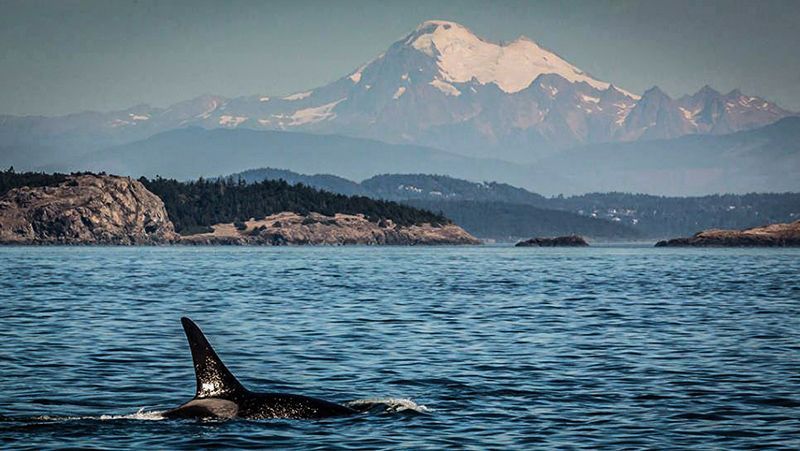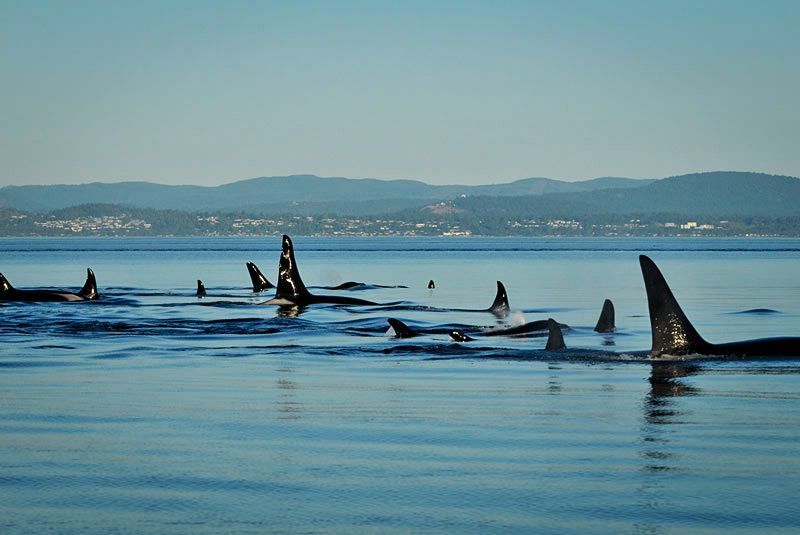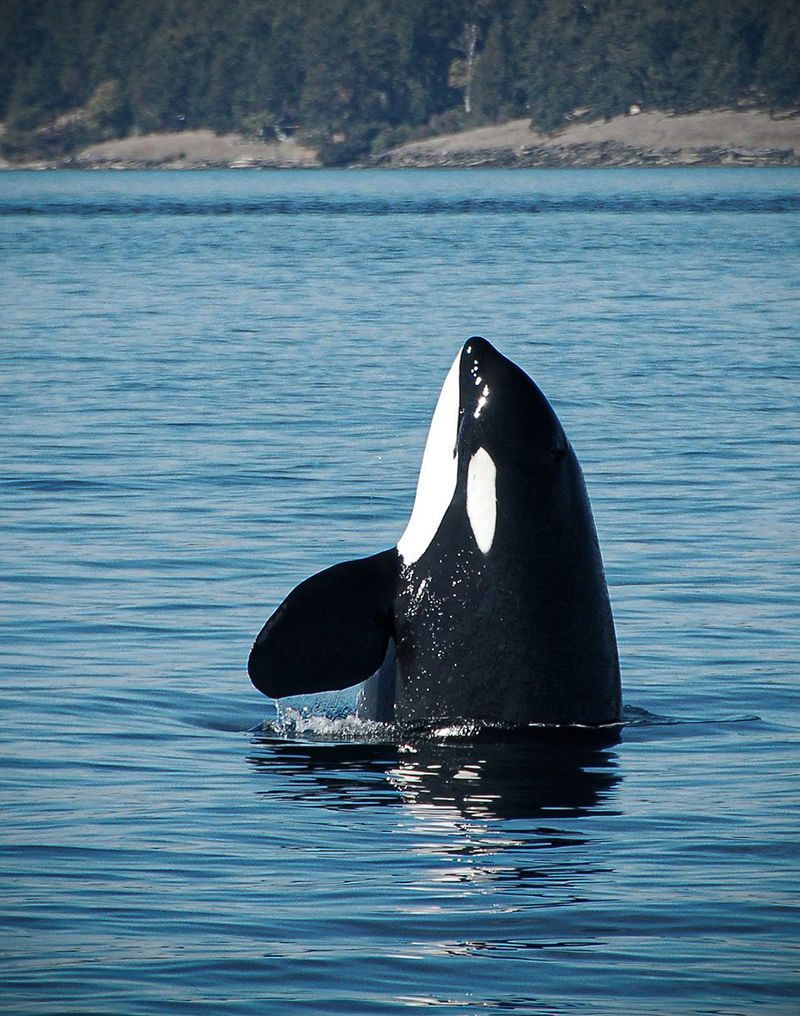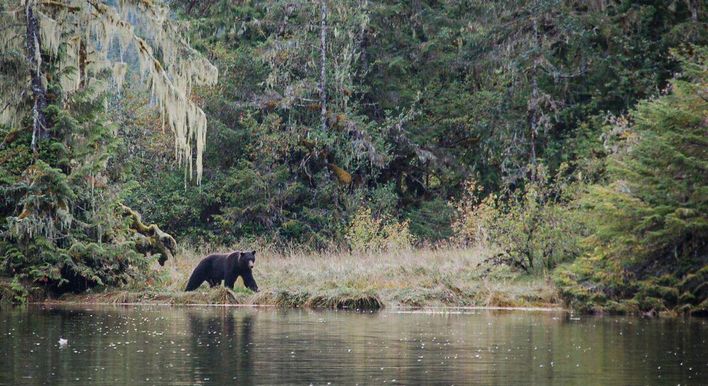Killer Whales
A tour we think you'll love
Orcas, also known as killer whales, are toothed whales and the largest member of the dolphin family. They are apex predators found in all of the world’s oceans and can be identified by their unique physical features, similar to human fingerprints. The dorsal fin and saddle patch vary in size, shape, pigmentation, and scarring, making it possible for researchers to identify individual orcas.
Orcas are one of thirty-five species in the oceanic dolphin family, Delphinidae, and the most cosmopolitan of all marine mammals. There are at least ten distinct ecotypes of orcas, with three ecotypes inhabiting Pacific Northwest waters: Resident, Bigg’s (Transient), and Offshore. An ecotype is a distinct population of a species that has adapted to a particular ecological niche or environment. In the case of marine mammals, different ecotypes can have distinct physical, behavioral, and vocal characteristics that are adapted to the specific environmental conditions of their habitat. For example, orcas have several different ecotypes, each with different feeding strategies and prey preferences.

Residents
The Southern Resident orca community, designated as J, K, and L pods, has been identified through these unique physical features, with a population of 73. Researchers can accurately determine the annual population count by keeping track of every individual orca. The Northern Resident orca community, comprised of A, G, and R clans, has over 300 individuals in 34 matrilines.
Transients
Bigg’s (Transient) orcas have a population estimated at 350 individuals and are more fluid in their family structure than residents. They have a pointed, shark-like dorsal fin and primarily feed on marine mammals such as seals, sea lions, porpoises, and even other whales.
Offshore
Offshore orcas were discovered in 1988 and are genetically distinct from Resident and Bigg’s orcas. They appear to be smaller and have a continuously rounded dorsal fin tip, and their saddle patch is usually solid.

Orcas are found in other parts of the world, such as the North Pacific, Antarctica, North Atlantic, Peninsula Valdez in Argentina, the Crozet Islands south of Madagascar, and New Zealand. They tend to congregate in certain areas, mostly in cold water.
Life Cycle
The life cycle of killer whales is similar to that of humans. Males begin to show signs of sexual maturity between twelve and fifteen years old, with their dorsal fin growing taller and straighter. They become fully physically mature around 25, but can sire offspring around age 20. The most recent estimate of the average male lifespan is 30 years (maximum 50-60 years). Females attain sexual maturity in their early teens and have an estimated average lifespan of 45 years with maximum ages between 80-90 years. Orca mating and calving take place year-round, with pregnancies lasting 18 months, one of the longest gestations of any mammal. Calves are born tail first with a collapsed dorsal fin, weighing approximately 400 lbs and typically nurse until their third year.
Southern Resident orcas have low reproductive output, with approximately 69% of pregnancies resulting in spontaneous abortion. The average SRKW female orca birthing rate is currently one viable calf per female every nine or ten years. Low reproductive output is attributed to reduced prey availability and toxins as the main threats to successful reproduction. Newborn calves have orange coloration on their underside and eyepatch and usually nurse into their third year. They gain strength, size, and weight during their first six months, shedding their skin and showing lots of exuberant and playful behavior.

How do you know?
Determining the sex of an orca is vital in gaining information about the breeding health of the population. Male killer whales have an elongated white pattern around their genital slit stretching toward the tail, while a female’s white pattern is more rounded with visible mammary slits.
Size
Female orcas typically develop to an average length of 18-22 feet and a weight of 8,000-11,000 lb. The largest recorded female orca measured 28 feet and weighed more than 15,000 lb.
Males are larger than females, usually growing up to 30 feet in length and weighing 12,000 lb to 16,000 lbs. Adult males are sexually dimorphic, – the condition where sexes of the same species exhibit different morphological characteristics – with the increased size of their dorsal fin indicating sexual maturity. The largest male orca on record measured 32 feet (9.8 meters) and weighed over 20,000 lb. At birth, orca calves weigh about 400 lb and are 7-8 feet long.
Looks are everything
The physical features of killer whales, or orcas, are quite distinctive. Orcas have a cylindrical shape, tapering at the head and flukes, and are characterized by their sharply contrasted black and white “tuxedo” coloring. Their black coloration is found on the head, rostrum, back, sides, pectoral fins, and flukes, while their throat, underside, and majority of the ventral side of their flukes are primarily white. This sharp contrast in coloration, along with their countershaded skin, allows orcas to blend with the ocean water and remain hidden from their prey when hunting.
An orca’s conical-shaped head has a small rostrum and a single blowhole used for breathing. Their eyes are located on the side of their head, just below and in front of their white eye patch, and behind and above the corner of their mouth. Orcas have excellent eyesight both above and below the ocean surface. They also have small ears with no external flap, but a highly developed sense of hearing, and use echolocation for hunting prey. Their mouth contains 10-13 conical teeth on each upper and lower jaw that tear into chunks of food.
Orcas have two large, roundish forelimbs called pectoral fins that are used for steering and stopping, working in conjunction with their flukes. Their dorsal fin is the largest of all marine mammals, reaching up to six feet tall in males, with a grayish-white saddle patch on each side and behind it. This saddle patch varies from individual to individual in shape, size, color, and scarring. Orcas also have two tail flukes, each half containing no bone or cartilage, just dense, fibrous connective tissue, and measure up to nine feet across in males. Their brain can weigh up to 15 pounds, and they have a 3“-4” layer of insulating blubber beneath their skin.

Remember to Breathe
Despite being conscious breathers, orcas do sleep, but they cannot sleep the same way humans do. They have to remember to breathe; otherwise, they will drown. Studies show that they sleep by shutting down one hemisphere of their brain at a time, similar to bottlenose dolphins and Beluga whales. Orcas swim at speeds of up to 28 knots (32 mph), but only briefly, with their travel speeds ranging from one to five knots. Observers have seen orcas rest by aligning abreast in a tight group at the water surface and moving slowly forward.
Socially Speaking
The Southern Resident killer whales (SRKW) have a well-defined social structure consisting of four levels. The first level is the matriline, which is the basic and most important social unit. It is made up of a female, her sons and daughters, and the offspring of her daughters. Individuals in a matriline share strong social bonds and seldom separate from the group for more than a few hours at a time. A single matriline can have as many as 17 members, but it is more usual for there to be five or six members.
The second level is the pod, which consists of groups of related matrilines. Matrilines within a pod share a common maternal ancestor from the recent past. Most pods consist of one to four matrilines. The third level is the clan, which is a group of pods that share similar vocal dialects and a common but older maternal heritage. Finally, the fourth level is the community, which is composed of pods and clans that regularly associate with one another. Communities are based solely on association patterns rather than maternal relatedness or vocal similarity.
The Southern Resident orca community is a single clan (J clan) and a single community. Three pods—J, K, and L—constitute the SRKWs, and these pods share a common ancestry. They socialize and feed together. Recent research has revealed that grandmothers play a critical role in the matrilines, pods, clans, and communities of orcas. The matriarchs teach other orcas how and where to fish, and they share the salmon they catch with younger whales in their pod.
Another study found that individuals within groups of associating whales had strong social preferences for particular individuals. These preferences led to the formation of “friendships,” and the orcas preferred to interact with whales of the same sex and similar age, sometimes with whales outside their family unit. Younger whales and females tended to be the most socially active, and the interaction between specific individuals involved physical contact. The study also found that orcas are less socially connected as they age.
It takes a village
Orcas are skilled hunters that use echolocation to locate food and are known to travel wherever their prey is found, making their movements less predictable than other whale species. The Southern Resident orca community consists of three pods that share a common ancestry and socialize and feed together. Grandmothers play a crucial role in the community, teaching the other orcas how and where to fish and sharing their catch with younger whales. Researchers have also found that orcas have strong social preferences for certain individuals, with younger whales and females being the most socially active.
The Resident orcas’ range is influenced by seasonal salmon migrations, with Southern Residents typically found in the Salish Sea and offshore of the Washington and Vancouver Island coasts during the spring, summer, and fall, and traveling as far north as Haida Gwaii and as far south as California’s San Francisco Bay Area during the winter. Northern Residents are commonly found in the waters around the north end of British Columbia’s Vancouver Island and in protected inlets along the province’s central and north coast during the spring, summer, and fall, and as far north as southeast Alaska during the winter. Bigg’s (Transient) orcas move in response to the location of their marine mammal prey, and offshore orcas have been observed between the Eastern Aleutian Islands and Southern California.
Make some noise
Although the Resident orcas are mostly quiet at the ocean surface, they use echolocation clicks to navigate and locate prey and various pulsed call types and tonal whistles to communicate, with each pod having a unique dialect. Orcas use sound to communicate, navigate, and hunt for food because daytime underwater visibility is minimal. The whales communicate by producing distinct sounds, including clicks, whistles, and calls, and the whales hear the sounds through the lower jaw, which picks up the sounds and carries them to the middle and inner ears. However, the ocean’s changing and unhealthy environment poses a threat to the orcas and their way of life.
Human activity and a changing ocean environment are having a profound impact on all orca ecotypes.
The SRKWs are protected as endangered in both Canada and the United States. Their primary threats include a lack of food, environmental contaminants, and noise and vessel disturbance. Reduced quantity and quality of their preferred prey, primarily Chinook salmon, is due to overfishing, barriers to spawning, habitat contamination, and poor ocean survival. Environmental pollutants from commercial, industrial, and household waste disposal and runoff enter the Pacific Ocean and accumulate in the orcas’ blubber, causing immune system repression and reproductive system dysfunction. Military exercises and vessel traffic disturbance can be deadly for orcas, and noise can interfere with their echolocation foraging abilities and communications.
The NRKWs are protected as threatened in Canada, and they face the same threats as the SRKWs. However, they may be more at risk from seismic surveys and oil and gas spills along British Columbia’s north coast and disease associated with ocean-pen fish farming.
The Bigg’s (Transient) orcas are protected as threatened in Canada, and their primary threats include persistent biochemicals in the environment and underwater noise and disturbance from vessel traffic and military exercises.
The Offshore orca population is protected as threatened in Canada, and they face high environmental levels of persistent biochemicals and severe and extended acoustic disturbance. An oil spill would be catastrophic for all orca populations. It is essential to address these threats and protect the orcas and their habitats for future generations.
Overall, the orca is a fascinating and unique species, a beautiful and magnificent apex predator with distinct physical features and varying ecotypes that are still being researched and discovered. We are humbled and awed by them whenever we are out sailing silently, hear that unmistakable spout and see that they have decided to graciously spend some time with us.








